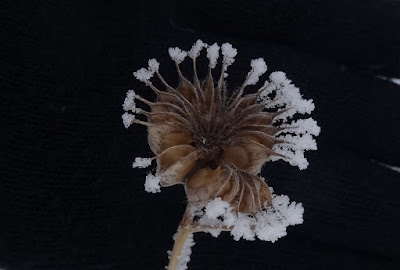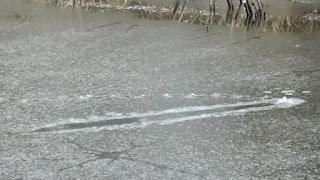2/20/2021
snow covered rocks
2/05/2021
winter gardening
Read more about the process at https://northerngardener.org/winter-sowing-perennials-works/
2/01/2021
1/28/2021
1/10/2021
velvetleaf
Many plants, which bloom and fruit in the warm growing season, stand bravely throughout the winter to ensure its seeds are fully distributed. This fruit capsule opened as it dried out in Autumn, and seeds have been coaxed out by the breeze. Now, it stands despite snow and hoarfrost.
Velvetleaf Abutilon theophrasti blooms in late summer with orange-yellow flowers on stems and leaves that really look and feel like they are cloaked in velvet. There were a few growing in the riparian buffer around the pond, but we pulled them because this plant is not native. It can form dense monocultures in place of native plants, suck large quantities of water and nutrients from the soil, and can inhibit germination of other plants.This in one of the plants that probably spreads from nearby crop fields, and that we try to keep out of the pond area.
12/28/2020
mourning doves
The seed feeders hang outside the deck railing. Sometimes the Mourning Doves line up on the rail, watching for their turn at the feeder. On some days they just sit here to crack and savor the seeds. We've seen ten at a time here, waiting or enjoying the food.
12/11/2020
crow
This American Crow Corvus brachyrhynchos is hunting near the frozen pond for something to eat.
It may be preparing to migrate . . . or not.Individual crows are consistent in whether they migrate or stay in the winter. Partial migration (where only some of a species migrate) might give crows enough flexibility to adapt to changing environmental conditions. Some we see in Minnesota now may have come south for the winter from Canada. Others, who breed and nest here, may have gone to Nebraska for the winter. Crows return faithfully to the same breeding territory each year.
11/22/2020
tracks, cracks, marks, mysteries
11/09/2020
temperamental autumn
11/08/2020
dabbling ducks
11/02/2020
sparrow feeding on shore
Evidently there are still damselflies or dragonflies among the reeds and grasses on the shore. This sparrow scored one while hopping in the shallow water of the pond.
10/31/2020
surviving below freezing - turtles
Since we had several cold days and nights already, Painted Turtles Chrysemys picta who live in the pond are getting ready for winter. Lacking summer heat, this one was wandering very very slowly for a food item or a place to settle. Turtles will spend the next several months in frigid pond water below the frozen ice, with their metabolism and their heart rate slowed way down. They can absorb oxygen from the water through vascularized areas in their mouth, throat, and anus (cloacal respiration). But using oxygen produces lactic acid in their body, which the turtle counteracts with minerals released from its shell and bones. Painted Turtles do not eat during this time, but they do remain alert, especially to light from above. In Spring, when the hours of daylight increase, they will respond.
10/28/2020
water sports
Sunny and warmer, closer to normal weather today, after an early snow in October. Several Mallards are getting ready for their travel south by feeding on the dwindling supply of plant material in the pond. But the resident muskrats do not like to share their food supply. We watched several encounters today between the animals.
10/24/2020
junco on snowy suet
Juncos arrived last week from nesting grounds north of here. Several made their way to our feeders. Usually, they stay in this area all winter, so it is important to locate some food sources before the snow flies. They will live on seeds from the native plants . . . and of course, suet.
10/20/2020
slush trail
Snow! Several inches. Before we were ready for it. Before the Mallards were ready for it. As they paddled around on the pond to find breakfast, they made a trail in the accumulating slush on the water.
10/19/2020
seed heads
I have been wandering the riparian buffer and clipping some of the wildflower seed heads to distribute them around the pond. Some native wildflowers exist here already, and we want to spread desirable plants throughout the buffer.
The clipping process is "a few for spreading to make new plants, most left for the birds."
Even after the seeds are gone, the structure of the plant is interesting!
10/18/2020
boneset in autumn
Boneset Eupatorium perfoliatum has a stout hairy stem, and the plant's leaves occur along it opposite to one another. In autumn, the flowers go to seed, and leaves turn a rich red-brown color.
The leaves are described as 'perfoliate' because each joins the opposite leaf around the stem so it appears the stem grows through one large leaf. All parts of this plant are toxic and bitter. Birds rarely eat the seeds, but are attracted to the flowers for the many insects there.
10/16/2020
10/08/2020
diving ducks
Mergansers stopped on the pond for a rest. They floated in the early sunlight for a while, then dived under water to search for a meal. Maybe they found aquatic insects, worms, frogs, or snails.
Below, the duck on the right is just gathering her body upward to curve down and dive. Because feathers make ducks buoyant, it takes muscles to dive. The one on the left is just emerging from a dive, as the water rolls off her head.
10/05/2020
floating pondweed
The floating leaves of Pondweed are fading at the end of summer. And the leaves of the nearby trees fall in the water, drift with the breeze, and catch on the Pondweed. They look golden in the sunlight, brighten the pond, and complement the wildflowers surrounding the water.
Floating Pondweed Potemogeton natans has two kinds of leaves; floating and submerged. The shiny leathery floating leaves are opaque, and support the whole plant which is rooted in the mud below. The submerged leaves are thin, transparent, and move with the water. In summer these plants provide habitats for many tiny aquatic invertebrates. These in turn are used as food by frogs, snakes, turtles, and ducks who feed here. After these plants die, their decomposition by bacteria and fungi provides food in turn for the aquatic invertebrates. The Pondweed survives winter with rhizomes buried in the mud at the bottom.
yellow loosestrife
9/28/2020
Phoebe in September

Phoebe is hunting at the pond today, balanced carefully on a reed bending over the water, with a reflection mirrored in the hazy sunlight.
Eastern Phoebes Sayornis phoebe are usually lone birds. Other than nesting season, one will rarely join another phoebe. They will sit upright and wag their tails from a low perch, looking for flying insects to eat.
They migrate south starting in September, wintering in the southern states. And, they are among the first migrants to return to their breeding grounds in spring, sometimes as early as March.

9/27/2020
muskrat tail
The muskrats who live here were gathering breakfast this morning in the pond. One, with tail held high, munched aquatic plants growing to just below the water surface. Their tails are 7 to 11 inches long, covered in scales rather than fur, and flattened vertically (side-to-side) to serve as a rudder in swimming.


























